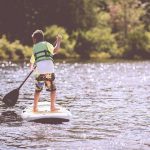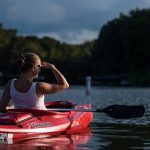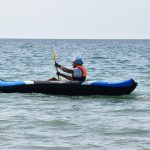We comprehend how this may be a valid query. Whether all you ever see are kayaking images like the one up above, it might be simple to question if kayaking is a good kind of fitness.
In fact, kayaking is a great upper body workout. Your back, shoulders, upper and lower arms, as well as your abdominal, may all be strengthened with the right form.
The technique is the key in the situation. Kayaking is a good workout if done correctly; otherwise, you run the danger of injuring your back, arms, or core muscles.
We advise novices to take a class to learn how to paddle a kayak because of this. Although there is a wealth of information regarding appropriate paddling methods online, nothing beats having a trainer critique your form in person and provide advice.
For harder types of kayaking, such as whitewater kayaking and kayak surfing, this is particularly crucial. The risk of damage increases as your main paddling activity gets more technical.
Is Kayaking Good Exercise?
It certainly is possible! Kayaking has the flexibility to be as leisurely or rigorous as you choose, which is one of its finest features.
You are more than welcome to paddle a short distance along the shore before relaxing in your kayak. You may also pace yourself and attempt to paddle 4-5 miles in less than two hours.
Your paddles may be made to be as long or short as you choose. It’s also crucial to keep in mind that various circumstances could need a variety of paddling excursions.
While your morning “workout” paddles may easily cover six miles in a couple of hours, your relaxing afternoon paddle with friends may only cover one or two miles.
At the end of the day, it’s up to you whether you see kayaking as a kind of workout or leisure activity. It may either be a substitute for or an addition to your current workout regimen.
What Muscles Does Kayaking Work?
You probably know precisely which muscles kayaking uses if you’ve lately paddled. Of course, if you were using the proper method. These are the muscles that kayaking should be engaging when done correctly.
Kayaking provides a full-body workout that hits a variety of muscle areas in addition to burning calories. Those who have joint problems can still be able to participate in the activity since it has a very minimal impact.
12 main muscular groups in the body, including the abs, biceps, triceps, lats, deltoids (shoulder), quadriceps (thighs), hamstrings (backside), quads (front side), glutes (buttocks), and calves, are all worked out by kayaking. Because kayaking is repetitive, it’s a great method to build arm, back, shoulder, and body muscles.
Shoulders
After a few hours of kayaking, the majority of individuals report feeling this muscular burning. Specifically, during your forward stroke, the blade of your kayak paddle is pulled through the water by your posterior deltoids.
We engage our posterior deltoids far more than their anterior relatives while kayaking since we spend the majority of our time moving forward rather than backward. You may become muscularly unbalanced as a result, which increases your risk of injury.
Because of this, many kayakers discover that they need to work out their anterior deltoids just as much as their posterior deltoids by going to the gym or engaging in other exercises. An experienced kayaker will most likely get an injury if this is not done.
Maintaining a good “paddler’s box” at all times is one method that you may assist prevent damage to your shoulders as a novice. This describes the rectangular shape that is formed inside of your arms and the paddle shaft when you position the shaft on top of your head.
Back
So, rather than being a single muscle, this is really a muscular group. Kayaking exercises your lats, lower and upper trapezius, and rhomboids, among other back muscles.
The biggest muscles in your back, the lats, contract each time you take a good forward stroke. These muscles get energy from your lower body and use it to assist in pulling your arm back and toward your body.
At the very conclusion of your forward paddle stroke, your rhomboids aid in pulling your scapula back. Focusing on rhomboid contraction might really be a crucial indicator for good posture and appropriate kayaking technique since they draw your shoulder blades forward.
Finally, your trapezius muscles help to rotate and bend your neck and spine in addition to moving your shoulders up and down. Being conscious of your middle and lower traps is crucial since many kayakers misuse their upper trapezius muscles.
Arms And Hands
There are many new kayakers that complain about this muscle area. Because they have to keep in touch with their kayak paddle, their hands and fingers often tire the quickest.
There is no need to hold your kayak paddle with a “white-knuckle” grip, I like to inform all of my beginner kayakers. Particularly when you start to paddle further distances, you should maintain your fingers as flexible and relaxed as possible.
Consequently, your forearms and hands are what convey all of the force from your lower body, core, shoulders, back, chest, and arms to your kayak paddle.
This is why kayaking is great for improving your grip strength in addition to being a great workout for the rest of your body.
Upper Arms
These are most likely the muscles that you had in mind when you originally considered taking up kayaking. The good news is that kayaking may unquestionably increase your triceps and biceps strength.
Your arms, shoulders, and back are probably tied for the most often utilized muscles when kayaking. But because your biceps and triceps muscles cooperate, there is no rivalry between them.
During a forward stroke, your bicep contracts in the pulling arm and your tricep contracts in the pushing arm as you draw one blade of your kayak paddle towards you (the opposite one).
Legs And Hips
You may be a little surprised by this one since when you imagine paddling a kayak, your lower body is usually the last thing on your mind. However, while kayaking, your legs, and hips put forth a lot of effort to transmit energy to your upper body and assist in stabilizing your core.
Pushing your feet up against the adjustable or built-in footrests in your kayak’s cockpit is proper kayaking form. A correct kayaking stroke starts at the moment when your feet touch the kayak.
Energy is then transported into your core, legs, back, shoulder, chest, and arm muscles from there. Kayaking can quickly turn into a full-body workout with the appropriate technique, not to mention the work your legs and hips perform when you start experimenting with more difficult movements like the lie-back method.
Reasons For Trying Out Kayaking As A Water Sport
1. You’ll have somewhere to turn to in summer for good relief from the scorching sun and cool everything inside you.
2. It’s a good activity for a romantic get-together for couples. In your life, you get to spend quality time together with your special partner while kayaking.
3. It is an all-time sport that doesn’t discriminate and reaches across generational lines. You can also enjoy it regardless of age.
4. As the saying goes, even a bad kayaking day is better than a good day at work; it offers a stress-free relief that is incomparable. If you’re looking forward to a good relaxation, you better try it out.
5. It enhances friendship and builds camaraderie from the bond of fellow kayakers. You should consider this sport whether you’re just hanging out as friends or sharing a competitive streak.
6. It is such great fun paddling a kayak if you’ve never tried it.
7. Compared to other activities, it offers you the ability to get close to nature. You’ll be able to see sights that are easily reached by a small percentage of the populace.
8. There’s a probability of unrestricted adventure in all kayaking environments, whether you’re exploring the island crevices or kayaking off a 20-foot waterfall.
9. Besides drifting up in a kayak, there’s no quieter way to access the inaccessible fishing holes. It is a part of another activity as it enhances and facilitates many other activities like complementing a weekend camping trip.
Benefits Of Kayaking
Are you aware that you can go Kayaking to improve your mental and physical health? Read on to discover how it’ll help aside from the obvious fun and enjoyment it offers.
| Mental Health Benefits Of Kayaking: | Physical Health Benefits Of Kayaking: |
| Allows time for self-reflection: You’ll get time to reconnect and reflect on yourself when you do it solo. All alone, you’ll have fun focusing on yourself while at the same time exploring. If you like meditating, this is the perfect activity with the perfect setting. | Fortifies your core muscles: During this workout, your lower back, obliques, and abdomen will be engaged. The muscles will contract on the lower back as you pull while your abs contract as you reach forward in every stroke. You then engage your obliques when you make any twisting motion. You’ll keep your muscles slightly engaged throughout the activity by keeping the kayak balanced and sitting upright. |
| Socializing and bonding: This makes it easy for everyone to start learning, Kayaking doesn’t entail any complicated concepts or instructions. You can share an enjoyable and memorable experience by asking any of your friends or family members to join you. | Develops the health of the heart: As a cardiac exercise, Kayaking improves the efficiency of the heart to pump blood. It increases your heart rate to a healthy level by increasing the number of blood cells in the body and efficient circulation. You’ll have a healthy and sturdy heart if you consistently kayak. |
| Improves your memory: It helps the brain stay healthy by being more active and regularly exercising. Raising the number of new brain cells, Kayaking consistently stimulates the growth of new red blood cells. | Develop toned legs: Kayaking has a significant effect on your arms and legs, although the benefits may be more evident on the shoulders, arms, and upper back. To keep you balanced on the kayak, your legs apply the needed pressure as you tighten and loosen the leg muscles, alternatively, countless times when you’re trying to maneuver or turn. |
| Reduces stress: That may be associated with various illnesses and exacerbate any existing medical condition you may have, stress is a huge factor in managing a mental illness. Kayaking provides you the same stress-relieving benefit, similar to how physical exercise helps in reducing stress. | Attain your perfect body weight: If you consistently kayak, you’ll be able to burn some calories and shed some weight. You can get your ideal weight by just allocating a few afternoons in a week for Kayaking if weight loss is one of your goals. |
| Develops your focus: When you exercise by Kayaking, neurotransmitters such as serotonin, norepinephrine, and dopamine are released, improving your focus and attention. | Upsurges your strength: You can withstand longer periods of effort without getting exhausted, and your stamina will be improved. Kayaking increases the amount of energy you can spend on your daily activities and enable you to do the activity longer. |
| Quality sleep: You’ll fall asleep much faster when you kayak during the day and get exhausted. The quality of your sleep will be improved, and you’ll stay longer in a deep sleep throughout the night, as you expend all the energy you have during the day. | Stimulates Vitamin D in your body: To produce Vitamin D, Kayaking exposes you to the sun to exhibit its effects on the body. In our system, we have the inactive form of the vitamin, and we can also get it from some food like cheese, beef liver, fatty fish, and others. |
FAQ
What are the basic requirements to get on Kayaking Workout?
Depending on the paddling you plan and the waterway demands, the exact requirements of a full kayaking kit may differ. But be sure to carry the following with you as you set out for the adventure;
1. A kayak
2. Two paddles, one as a spare, of course
3. Blige pump
4. Personal floatation devices such as a jacket or vest
5. A headlamp with spare batteries
6. A spray deck for keeping the water away from the craft
7. Suitable clothing
8. Helmet and a wetsuit




